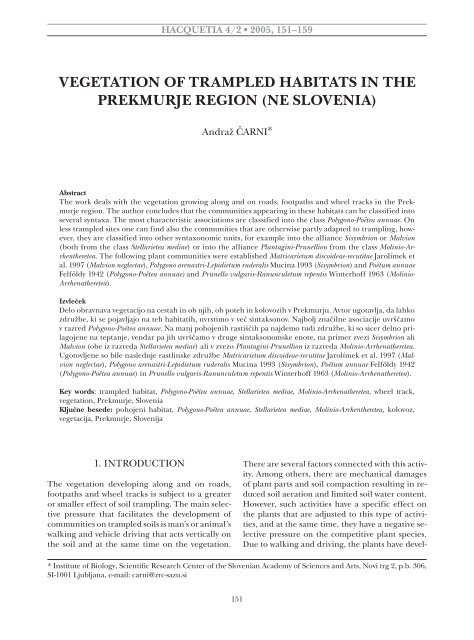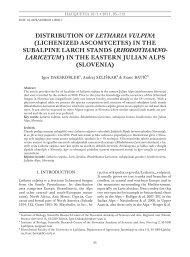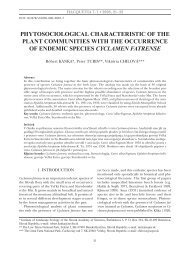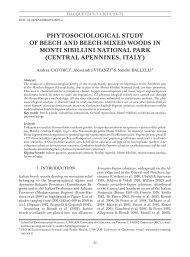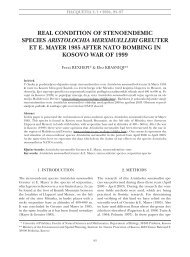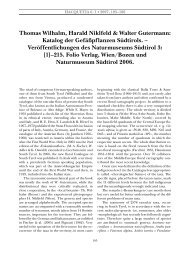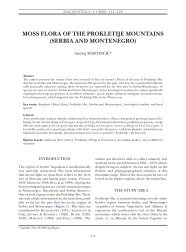1. PDF dokument (341 kB) - dLib.si
1. PDF dokument (341 kB) - dLib.si
1. PDF dokument (341 kB) - dLib.si
Create successful ePaper yourself
Turn your PDF publications into a flip-book with our unique Google optimized e-Paper software.
HACQUETIA 4/2 • 2005, 151–159<br />
VEGETATION OF TRAMPLED HABITATS IN THE<br />
PREKMURJE REGION (NE SLOVENIA)<br />
Andraž ČARNI*<br />
Abstract<br />
The work deals with the vegetation growing along and on roads, footpaths and wheel tracks in the Prekmurje<br />
region. The author concludes that the communities appearing in these habitats can be clas<strong>si</strong>fied into<br />
several syntaxa. The most characteristic associations are clas<strong>si</strong>fied into the class Polygono-Poëtea annuae. On<br />
less trampled <strong>si</strong>tes one can find also the communities that are otherwise partly adapted to trampling, however,<br />
they are clas<strong>si</strong>fied into other syntaxonomic units, for example into the alliance Sisymbrion or Malvion<br />
(both from the class Stellarietea mediae) or into the alliance Plantagini-Prunellion from the class Molinio-Arrhentheretea.<br />
The following plant communities were established Matricarietum discoideae-recutitae Jarolímek et<br />
al. 1997 (Malvion neglectae), Polygono arenastri-Lepidietum ruderalis Mucina 1993 (Sisymbrion) and Poëtum annuae<br />
Felföldy 1942 (Polygono-Poëtea annuae) and Prunello vulgaris-Ranunculetum repentis Winterhoff 1963 (Molinio-<br />
Arrhenatheretea).<br />
Izvleček<br />
Delo obravnava vegetacijo na cestah in ob njih, ob poteh in kolovozih v Prekmurju. Avtor ugotavlja, da lahko<br />
združbe, ki se pojavljajo na teh habitatih, uvrstimo v več <strong>si</strong>ntaksonov. Najbolj značilne asociacije uvrščamo<br />
v razred Polygono-Poëtea annuae. Na manj pohojenih rastiščih pa najdemo tudi združbe, ki so <strong>si</strong>cer delno prilagojene<br />
na teptanje, vendar pa jih uvrščamo v druge <strong>si</strong>ntaksonomske enote, na primer zvezi Sisymbrion ali<br />
Malvion (obe iz razreda Stellarietea mediae) ali v zvezo Plantagini-Prunellion iz razreda Molinio-Arrhenatheretea.<br />
Ugotovljene so bile naslednje rastlinske združbe Matricarietum discoideae-recutitae Jarolímek et al. 1997 (Malvion<br />
neglectae), Polygono arenastri-Lepidietum ruderalis Mucina 1993 (Sisymbrion), Poëtum annuae Felföldy 1942<br />
(Polygono-Poëtea annuae) in Prunello vulgaris-Ranunculetum repentis Winterhoff 1963 (Molinio-Arrhenatheretea).<br />
Key words: trampled habitat, Polygono-Poëtea annuae, Stellarietea mediae, Molinio-Arrhenatheretea, wheel track,<br />
vegetation, Prekmurje, Slovenia<br />
Ključne besede: pohojeni habitat, Polygono-Poëtea annuae, Stellarietea mediae, Molinio-Arrhentheretea, kolovoz,<br />
vegetacija, Prekmurje, Slovenija<br />
<strong>1.</strong> INTRODUCTION<br />
The vegetation developing along and on roads,<br />
footpaths and wheel tracks is subject to a greater<br />
or smaller effect of soil trampling. The main selective<br />
pressure that facilitates the development of<br />
communities on trampled soils is man’s or animal’s<br />
walking and vehicle driving that acts vertically on<br />
the soil and at the same time on the vegetation.<br />
There are several factors connected with this activity.<br />
Among others, there are mechanical damages<br />
of plant parts and soil compaction resulting in reduced<br />
soil aeration and limited soil water content.<br />
However, such activities have a specific effect on<br />
the plants that are adjusted to this type of activities,<br />
and at the same time, they have a negative selective<br />
pressure on the competitive plant species.<br />
Due to walking and driving, the plants have devel-<br />
* Institute of Biology, Scientific Research Center of the Slovenian Academy of Sciences and Arts, Novi trg 2, p.b. 306,<br />
SI-1001 Ljubljana, e-mail: carni@zrc-sazu.<strong>si</strong><br />
151
Hacquetia 4/2 • 2005<br />
oped typical growing forms, for instance rosettes<br />
(Plantago), creeping stems (Trifolium) or tussocks<br />
(Gramineae). (Čarni & al. 2002)<br />
In Europe, the pioneer plant communities appearing<br />
on trampled soils are mainly clas<strong>si</strong>fied into<br />
the class Polygono-Poëtea annuae (Rivas-Martínez<br />
1972). The communities are built mostly by therophytes<br />
(for instance, Chamomilla suaveloens, Poa annua)<br />
reaching their optimal phase of development<br />
in late spring and in early summer. Later on, those<br />
species occur that are adjusted to high temperatures<br />
and are known for their C4 photosynthetic<br />
pathway. They reach their optimum of development<br />
in the second half of the summer (Čarni &<br />
Mucina 1998). These communities are not dealt<br />
with in this reseach.<br />
Moreover, certain other communities can also<br />
be con<strong>si</strong>dered as trampled communities. However,<br />
they are clas<strong>si</strong>fied into other syntaxa, for instance,<br />
into the class of weed and ruderal communities<br />
Stellarietea mediae and the class of anthropogenic<br />
meadows on deeper, more or less fertile soils of<br />
lowland regions Molinio-Arrhenatheretea.<br />
The association Marticarietum discoideae-recutitae<br />
has been clas<strong>si</strong>fied into Malvion, the alliance of annual,<br />
ruderal and therophytic communities that<br />
reach their phenological optimum in summer.<br />
The communities are found in lowlands with a<br />
warm climate. They grow on waste material and<br />
on loose soils rich in organic substances, very often<br />
rich in nitrates from organic material or from<br />
liquid manure. The communities from the alliance<br />
Malvion appear in planar and collin vegetation<br />
belts. The area of distribution of the alliance<br />
spreads in subcontinental central Europe and in<br />
the eastern part of the Balkan peninsula (Mucina<br />
1993).<br />
The association Polygono-Lepidietum has been<br />
clas<strong>si</strong>fied into Sisymbrion, the alliance of annual<br />
ruderal communities that develop on open, nitrophilic<br />
<strong>si</strong>tes in settlements and also elsewhere in<br />
the cultural landscape. Mostly these are species<br />
poor communities. The soils are loose and they<br />
dry out very quickly <strong>si</strong>nce they are rich in bedrock<br />
and therefore permeable (Pott 1995, Mucina<br />
1993).<br />
The community that is found on forest footpaths<br />
is clas<strong>si</strong>fied into the order Plantagini-Prunelletalia<br />
of the class Molinio-Arrhenathereta. The order<br />
of Plantagini-Prunelletalia comprises hemicryptophytic<br />
trampled communities that grow on shady<br />
<strong>si</strong>tes. In the communities, there are numerous<br />
broad-leaved and low herb species whereas the<br />
mezzophyllous grasses are of lower importance.<br />
The typical <strong>si</strong>tes for this vegetation are forest footpaths<br />
where usually the association Prunello-Ranunculetum<br />
repentis appears. In these communities,<br />
relatively few plant species appear (Ellmauer &<br />
Mucina 1993).<br />
2. DESCRIPTION OF THE AREA AND<br />
METHODS<br />
The Prekmurje region lies in the northerneast of<br />
Slovenia (Fig. 1). Geographically, it is limited by<br />
the Austrian, Hungarian and Coatian border and<br />
the Mura river. It measures 948 km 2 . The geological<br />
bedrock con<strong>si</strong>sts mainly of miocenic and pliocenic,<br />
and partly also of holocenic sediments. On<br />
this bedrock the eutric and dystric leptosol develops<br />
and eutric and dystric cambisols that proceed<br />
one type of soil into another one under man’s influence<br />
(Stepančič 1984). The climate can be clas<strong>si</strong>fied<br />
into the moderate continental climate of<br />
eastern Slovenia (Subpannonic climate). It is characterized<br />
by more a pronounced continental precipitation<br />
regime with an annual quantity of precipitation<br />
between 1000 and 800 mm, and by the<br />
fact that April temperatures equal or exceed the<br />
October ones. Figure 2 shows the climadiagram<br />
for Lendava, where the annual quantity of precipitation<br />
equals 811 mm with a maximum in July and<br />
November (Ogrin 1996). In this area, the most frequent<br />
community is Castaneo-Fagetum that could be<br />
found on hilly <strong>si</strong>tes in the northern part of the region.<br />
The plains are mostly cultivated, here and<br />
there, there are individual hornbeam tree forests<br />
(Pruno padi-Carpinetum). On the plains, larger forest<br />
surfaces appear along water currents and in<br />
marshy regions, particularly the forests dominated<br />
by oak, alder and willow trees (Marinček & Čarni<br />
2002).<br />
The vegetation was sampled and studied according<br />
to the standard Central European method<br />
(Braun-Blanquet 1964, Westhoff & van der Maarel<br />
1973) whereas the nomenclature of plant species<br />
follows Ehrendorfer (1973) and Martinčič (2003).<br />
In Slovenia, the vegetation of trampled <strong>si</strong>tes<br />
has been researched by a few researchers, like for<br />
example Čarni (1996) in the Submediterranean<br />
area, Marković (1984) in the Predinaric and Dinaric<br />
region, Šilc (2001, 2002) in Central Slovenia,<br />
and Marković (2000) in the Subpannonian region.<br />
152
Andraž Čarni: Vegetation of trampled habitats in the Prekmurje region (ne Slovenia)<br />
Figure 1: Research area (left); Figure 2: Climadiagram for Lendava (after Ogrin 1996) (right).<br />
Slika 1: Področje raziskav (levo); Slika 2: Klimadiagram Lendave (po Ogrinu 1996) (desno).<br />
3. RESULTS<br />
a) Syntaxonomical scheme<br />
Stellarietea mediae R.Tx. Lohmeyer et Prei<strong>si</strong>ng in R.<br />
Tx. ex Rochow 1951<br />
Sisymbrietalia J. Tx. in Lohmeyer et al. 1962<br />
Malvion neglectae (Gutte 1966) Hejný 1978<br />
Matricarietum discoideae-recutitae<br />
Jarolímek et al. 1997<br />
Sisymbrion officinale R. Tx., Lohmeyer et<br />
Prei<strong>si</strong>ng in R. Tx. 1950<br />
Polygono arenastri-Lepidietum ruderalis<br />
Mucina 1993<br />
Polygono arenastri-Poëtea annuae Rivas-Martínez<br />
1975 corr. Rivas-Martínez et al. 1991<br />
Polygono arenastri-Poëtalia annae R. Tx. in Géhu<br />
et al. 1972<br />
Marticario matricarioidis-Polygonion arenastri<br />
Rivas-Martínez 1975 corr. Rivas-Martínez et<br />
al. 1991<br />
Poëtum annuae Felföldy 1942<br />
Molinio-Arrhenatheretea R. Tx. 1937 em. R. Tx. 1970<br />
Plantagini-Prunelletalia Ellmauer et Mucina<br />
1993<br />
Plantagini-Prunellion Eliáš 1980<br />
Prunello-Ranunculetum repentis Winterhoff<br />
1963<br />
b) Description of plant communities<br />
3.<strong>1.</strong> Matricarietum discoideae-recutitae Jarolímek<br />
et al. 1997 (Tab. 1)<br />
The community, clas<strong>si</strong>fied into the alliance Malvion<br />
was described by Jarolímek and coauthors (1997)<br />
in Slovakia. The community appears on holding<br />
yards where the poultry is pastured from time to<br />
time. The <strong>si</strong>tes are sunny or partly shady, fresh to<br />
dry, rich in nitrogen and only moderately trampled<br />
(Jarolímek & al. 1997).<br />
In the Prekmurje region, the community frequently<br />
appears in courtyards that are still traditionally<br />
managed although such <strong>si</strong>tes are in the<br />
process of gradual disappearance. The community<br />
was sampled on wheel tracks between fields where<br />
working machinery and equipment are utilized, so<br />
that the vegetation on these <strong>si</strong>tes is only moderately<br />
trampled. The <strong>si</strong>tes are rather eutrophic. The vegetation<br />
was clas<strong>si</strong>fied into the alliance of Malvion,<br />
although there are several species from the alliance<br />
Matricario-Polygonion representing the tran<strong>si</strong>tional<br />
character of this association between two alliances<br />
and classes at the same time as was already quoted<br />
by Jarolímek & al. (1997).<br />
153
Hacquetia 4/2 • 2005<br />
The community is poorly developed due to the<br />
small surface area between wheels on wheel tracks.<br />
The community is species poor; there appear less<br />
than ten species, whereas more than 20 (Jarolímek<br />
& al. 1997) can be found in the optimally developed<br />
community. The dominant species in stands<br />
is Chamomilla recutita and there appear with higher<br />
cover values also Polygonum arenastrum and Matricaria<br />
suaveolens.<br />
Table 1: Analytical table of the community Matricarietum<br />
discoideae-recutitae.<br />
Tabela 1: Analitična tabela združbe Matricarietum<br />
discoideae-recutitae.<br />
Relevé number 1 2<br />
Surface (m 2 ) 5 4<br />
Coverage (%) 80 80<br />
Inclination ( o ) 0 0<br />
Chamomilla recutita 3 2<br />
Matricaria suaveloens 2 1<br />
Polygonum arenastrum 3 2<br />
Bromus hordeaceus + .<br />
Agropyron repens + 2<br />
Digitaria sanguinalis + .<br />
Dactylis glomerata + +<br />
Capsella bursa-pastoris . +<br />
Plantago major . +<br />
Conyza canaden<strong>si</strong>s . +<br />
Chenopodium album . +<br />
Achillea collina . +<br />
Localities: <strong>1.</strong> Pince Marof, in wheel tracks between fields,<br />
5. 7. 2001, altitude 155 m, lat. 46°30’48’’, long. 163°0’46’’; 2.<br />
Pince Marof, in wheel tracks between fields, 5. 7. 2001, 150<br />
m, 46°31’30’’, 16°29’30’’.<br />
3.2. Polygono arenastri-Lepidietum ruderalis<br />
Mucina 1993 (Tab. 2)<br />
As described by Mucina (1993), the community appears<br />
relatively frequently in Austria where it is<br />
found on road verges, along railways and along<br />
house walls. Within this community, many species<br />
can be found that are re<strong>si</strong>stant to trampling, which<br />
results in the tran<strong>si</strong>tional character of the community<br />
between the alliances of Sisymbrion and Matricario-Polygonion<br />
arenastri. Certain authors (for example,<br />
Jarolímek & al. 1997) clas<strong>si</strong>fy it into the alliance<br />
of Matricario-Polygonion.<br />
Be<strong>si</strong>des the dominant species Lepidium ruderale<br />
there often appear also Poa annua and Dactylis glomerata.<br />
The community does not appear very often<br />
in the area concerned, however, it can be found<br />
along road verges and on sandy parking places.<br />
The community is poor in species, which is characteristic<br />
of the communities from the alliance Sisymbrion<br />
(Mucina 1993).<br />
Table 2: Analytical table of the community Polygono-<br />
Lepidietum.<br />
Tabela 2: Analitična tabela združbe Polygono-Lepidietum.<br />
Relevé number 1 2 3<br />
Surface (m 2 ) 4 2 3<br />
Coverage (%) 40 60 50<br />
Inclination ( o ) 0 0 0<br />
Lepidium ruderale 3 4 3<br />
Poa annua 1 1 +<br />
Dactylis glomerata + + 2<br />
Plantago major 1 1 .<br />
Matricaria discoidea + 1 .<br />
Capsella bursa-pastoris + + .<br />
Plantago major + . +<br />
Agropyron repens + . .<br />
Rumex crispus + . .<br />
Poa compressa + . .<br />
Polygonum arenastrum . + .<br />
Localities: <strong>1.</strong> Kobilje, on the parking places, 26.5.2000, 180 m,<br />
2. Pince, on the filled gravel near the cemetery, 26.5.2000,<br />
163 m, 3. Pince Marof, on the filled gravel, 26.5.2000, 155 m.<br />
3.3. Poëtum annuae Felföldy 1942 (Tab. 3)<br />
The community from the alliance Matricario-Polygonion,<br />
dominated by the therophytic species Poa annua<br />
appears across the entire area studied. It can<br />
be ranked among the most frequent ruderal communities.<br />
The stands appear on different <strong>si</strong>tes, on<br />
footpaths, on parking places, along roads, in front<br />
of buildings and <strong>si</strong>milar. The community reaches<br />
its optimum in late spring, whereas the therophytic<br />
species decay in peak summer months. In addition<br />
to the dominant species, there are other species<br />
like Plantago major, Lolium perenne, Marticaria discoidea<br />
and Polygonum arenastrum growing in this community<br />
more or less constantly.<br />
The community was con<strong>si</strong>dered as Lolio-Plantaginetum<br />
Berger 1930 poëtosum Krippelová 1972 by<br />
some authors or as the community with a species<br />
Poa annua [Polygono-Poëtea annuae] (Mucina 1993)<br />
in compliance with the deductive method of Kopecký<br />
(Kopecký & Hejný1974).<br />
154
Andraž Čarni: Vegetation of trampled habitats in the Prekmurje region (ne Slovenia)<br />
Table 3: Analytical table of the community Poëtum annuae.<br />
Tabela 3: Analitična tabela združbe Poëtum annuae.<br />
Relevé number 1 2 3 4 5 6 7 8 9 10 11<br />
Surface (m 2 ) 4 10 10 - 5 5 8 8 8 8 8<br />
Coverage (%) 80 80 60 80 80 80 70 80 80 80 80<br />
Aspect S - S - - - - - - - -<br />
Inclination (°) 2 - 2 - - - - - - - -<br />
Number of species 13 13 11 9 15 12 17 10 9 10 17 Presence<br />
Ass. char. species<br />
Poa annua 4 3 3 4 3 4 3 4 4 4 4 11<br />
PP<br />
POLYGONO-POËTEA ANNUAE<br />
Matricaria discoidea + . . + + 1 + + 1 + + 9<br />
Polygonum arenastrum + + + + + + + . . . + 8<br />
Spergularia rubra . . . . . . . 1 + + + 4<br />
Sagina procumbens . . . . . . + + . + . 3<br />
Other species<br />
Lolium perenne + + 1 2 2 + + 2 2 1 2 11<br />
Plantago major 3 3 2 3 3 1 2 1 + 2 1 11<br />
Trifolium repens 1 2 + . 1 + + 1 . . + 8<br />
Taraxacum officinale + + + + 1 + . . . . + 7<br />
Medicago lupulina + + . . . + + + . . . 5<br />
Dactylis glomerata . . + . + . . + + . + 5<br />
Plantago lanceolata + + . . 1 . . . . . + 4<br />
Capsella bursa- pastoris . + + . + 1 . . . . . 4<br />
Carex hirta . + + + . . + . . . . 4<br />
Veronica arven<strong>si</strong>s . . . . . . + . 1 + + 4<br />
Cerastium glomeratum 1 + . . . . . . . . + 3<br />
Achillea collina . + . . + . . . + . . 3<br />
Juncus tenuis . + . . . + + . . . . 3<br />
Ranunculus repens . . . + . . + . + . . 3<br />
Poa trivialis . . . . + . + . . . . 2<br />
Aphanes arven<strong>si</strong>s . . . . . . . + . + . 2<br />
Festuca arundinacea . . . . . . . . . + + 2<br />
Localities: <strong>1.</strong> Veščica, 8.6.1999, 195 m, on the filled gravel, 2. Veščica, 8.6.1999, 195 m, at the entrance into the cemetery, on<br />
the gravel, 3. Bukovniško jezero, 8.6. 1999, 190 m, on the filled gravel at the parking place along the lake, 4. Gornji Slaveči,<br />
9.6.1999, 250 m, on the filled gravel in front of the fire station, 5. Ižakovci, 8.6.1999, 180 m, in the middle of wheel tracks, 6.<br />
Dokležovje, 8.6.1999, 180 m, on the gravel near the football field NK Dokležovje, 7. Moravci, 8.6.1999, 190 m, on the parking<br />
place near a store, on the filled gravel, 8. Moravci, 8.6.1999, 190 m, on the filled gravel near a store, 9. Moravci, 8.6.1999,<br />
190 m, on the gravel on the parking place in front of a store, 10. Moravci, 8.6.1999, 190 m, on the filled gravel on the parking<br />
place in front of a store, 1<strong>1.</strong> Moravci, 8.6.1999, 190 m, on the filled gravel on the parking place in front of a store.<br />
Less common species: <strong>1.</strong> Festuca sp. +, Rorippa sylvestris + , Trifolium campestre +, 3. Epilobium montanum +, Hypericum<br />
perforatum +, 5. Apera spica-venti +, Artemi<strong>si</strong>a vulgaris +, Erigeron annuus +, 6. Lepidium virginicum 1, Arenaria serpyllifolia<br />
+, 7. Bellis perennis +, Filaginella uliginosa +, Trifolium dubium +, 10. Scleranthus annuus +, 1<strong>1.</strong> Diplotaxis tenuifolia +, Papaver<br />
rhoeas +, Sagina apetala +, Vulpia myuros +.<br />
155
Hacquetia 4/2 • 2005<br />
3.4. Prunello-Ranunculetum repentis Winterhoff<br />
1963 (Tab. 4)<br />
The community thrives on less trampled soils, in forest<br />
wheel tracks, located on partly shady <strong>si</strong>tes. This<br />
community is dominated by the hemicryptophytic<br />
species that are re<strong>si</strong>stant to a definite extent of trampling<br />
like Prunella major, Plantago major, Juncus tenuis<br />
joined by therophytic species like Poa annua, Oxalis<br />
stricta, Stellaria media. The forests species also appear<br />
frequently like Carex sylvatica, Poa nemoralis, Stachys<br />
sylvatica and numerous other ones. The species from<br />
the class Galio-Urticetea (e.g. Urtica dioica, Impatiens<br />
parviflora) and class Bidentetea (e.g. Polygonum hidropiper,<br />
P. mite) appear frequently as well.<br />
The communities were not clas<strong>si</strong>fied into lower<br />
syntaxons, <strong>si</strong>nce Faliński (1963) distinguishes the<br />
variant with Juncus tenuis and Jarolímek (1980) the<br />
subassociation veronicetosum serpyllifoliae. However,<br />
the community growing in the area studied could<br />
hardly be clas<strong>si</strong>fied into one of the already described<br />
lower units. Consequently, the clas<strong>si</strong>fication<br />
into lower units was not carried out.<br />
The association was de<strong>si</strong>gnated as Prunello-Ranuculetum<br />
repentis Winterhoff 1963 and Prunello vulgaris-Plantaginetum<br />
Faliński 1963 or Prunella vulgaris-Agrostietea<br />
Gesellschaft (Schall 1988) was taken<br />
as synonym in accordance with Ellmauer &<br />
Mucina (1993) as well as Jarolímek & Zaliberová<br />
(1995).<br />
Table 4: Analytical table of the community Prunello-Ranunculetum repentis.<br />
Tabela 4: Analitična tabela združbe Prunello-Ranunculetum repentis.<br />
Relevé number 1 2 3 4 5 6 7 8 9 10 11<br />
Surface (m 2 ) 10 20 20 20 15 15 20 20 15 20 20<br />
Coverage (%) 90 70 60 70 70 90 70 70 70 70 70<br />
Layer C 80 65 60 70 60 90 70 70 70 65 70<br />
Layer D 20 5 10 30 20 5 0 0 1 5 1<br />
Aspect - W SE E - - - - - W -<br />
Inclination (°) 0 2 2 1 0 0 0 0 0 2 0<br />
Number of species 36 33 29 30 37 28 12 22 31 26 25 Presence<br />
Ass. char. and diff. species<br />
Prunella vulgaris 3 2 3 2 1 1 2 2 3 2 1 11<br />
Plantago major + + 1 2 1 1 2 2 2 + + 11<br />
Juncus tenuis 1 + 2 2 + 1 + 1 . + + 10<br />
MA<br />
MOLINIO-ARRHNETHERETEA<br />
Ranunculus repens 1 1 1 + 2 1 . . 2 2 2 9<br />
Veronica serpyllifolia + + + + + + + + + + . 10<br />
Taraxacum officinale + . + + . + . + + . . 6<br />
Cerastium holosteoides . + + + + . . + + . . 6<br />
Ly<strong>si</strong>machia nummularia + . + . . . . . + 2 1 5<br />
Poa trivialis . + + + . + . . + . . 5<br />
Trifolium repens . . . + + 1 + + . . . 5<br />
Campanula patula . + + . + . . . . + . 4<br />
Achillea millefolium . . . + + + . . . . . 3<br />
Dactylis glomerata + . . . + . . + . . . 3<br />
Ranunculus acris + . . + . . . . . . + 3<br />
Holcus lanatus . + + . . . . . . . + 3<br />
Agrostis stolonifera . . . . + 1 . . 1 . . 3<br />
QF<br />
QUERCO-FAGETEA<br />
Carex sylvatica + + + . . + + + . + + 8<br />
Poa nemoralis 2 . + + 1 . + . + . + 7<br />
156
Andraž Čarni: Vegetation of trampled habitats in the Prekmurje region (ne Slovenia)<br />
Relevé number 1 2 3 4 5 6 7 8 9 10 11<br />
Stachys sylvatica + + . . . . . . . + + 4<br />
Viola reichenbachiana + + + . + . . . . . . 4<br />
Rumex sanguineus + . . . + + . . . . . 3<br />
Carex remota . + . + . . . . . . 1 3<br />
Lycopus europaeus . . . + . . . . 1 . 2 3<br />
Carpinus betulus juv. + . . . . + . . . . . 2<br />
Lamium montanum + . . . . . . . . + . 2<br />
Agrostis capillaris . + . . + . . . . . . 2<br />
Anemone nemorosa . + . . . . . + . . . 2<br />
Mycelis muralis . + . . . . . + . . . 2<br />
Asperula odorata . + . . . . . . . + . 2<br />
Stachys palustris . . + . . . . . . + . 2<br />
Other species<br />
Poa annua 1 2 2 1 1 2 3 2 1 + . 10<br />
Oxalis stricta + . + + 1 1 + + + + + 10<br />
Stellaria media 2 + + + + + . + 1 + . 9<br />
Eurynchium hians var. hians* + + 2 1 2 + . . . + + 8<br />
Ajuga reptans + . . + 1 + . . + . 3 6<br />
Cardamine impatiens + . . . 1 + + + . . + 6<br />
Polygonum hidopiper + 1 + . . . . + + + . 6<br />
Erigeron annuus + . . + + . + . . . + 5<br />
Sagina procumbens + . 1 + + . . . . . . 4<br />
Brachythecium mildeanum* + . + + + . . . . . . 4<br />
Atrichum undulatum* . 1 + + . . . . . + . 4<br />
Urtica dioica . . + . + . . + + . . 4<br />
Agropyron repens . . + . . . . + + 1 . 4<br />
Cerastium glomeratum + . 1 . + . . . . . . 3<br />
Geum urbanum + . . . . + . . + . . 3<br />
Impatiens parviflora + . . . + . . + . . . 3<br />
Veronica chamaedrys . 1 + . . . . . . + . 3<br />
Plagiomnium affine* . + . . . + . . . + . 3<br />
Lapsana communis . . + . + . . . . . + 3<br />
Galeop<strong>si</strong>s speciosa . . . . + + . . . + . 3<br />
Glechoma hederacea . . . . . + . + . . 2 3<br />
Polygonum mite . . . . . + . . + . + 3<br />
Alliaria petiolata + . . . . . + . . . . 2<br />
Chenopodium album + . . . . . . . + . . 2<br />
Moehringia trinervia . + . + . . . . . . . 2<br />
Clinopodium vulgare . + . . . . . . . 1 . 2<br />
Prunella laciniata . + . . . . . . . + . 2<br />
Fragaria vesca . + . . . . . . . + . 2<br />
Solidago virgaurea . + . . . . . . . + . 2<br />
Caliergonella lindbegii* . . . 2 + . . . . . . 2<br />
Polygonum hidropiper . . . . + + . . . . . 2<br />
Localities: <strong>1.</strong> Hraščica, 14.6.2000, 180 m, wheel tracks, 2. Bukovnica, 15.6.2000, 200 m, forest footpath, 3. Kobilje, 14.6.2000,<br />
205 m, forest footpath, 4. Kobilje, 14.6.2000, 205 m, forest footpath, 5. Hraščica, 14.6.2000, 180 m, forest footpath, 6. Trnjavski<br />
log, 15.6.2000, 170 m, forest footpath, 7. Renkovci (Hraščica), 15.6.2000,180 m, forest footpath, 8. Renkovci, 15.6.2000, 180 m,<br />
forest footpath, 9. Trnjavski log, 15.6.2000, 170 m, forest footpath, 10. Bukovnica, 15.6.2000, 200 m, forest footpath, 1<strong>1.</strong><br />
Bogojina, close to Bogojina hunting lodge, 15.6.2000, 240 m, forest footpath.<br />
157
Hacquetia 4/2 • 2005<br />
Less common species: <strong>1.</strong> Aegopodium podagraria +, Anthiscus sylvestris +, Circaea lutetiana +, Geranium phaeum +, Myosotis<br />
spar<strong>si</strong>flora +; 2. Luzula pilosa +, Milium effusum +, Solidago serotina +, Veronica montana +; 3. Geranium robertianum +; 4.<br />
Amblystegium serpens* +, Hypericum perforatum +, Polygonum aviculare agg. +, Schrophularia nodosa +, Trifolium dubium +; 5.<br />
Filagenella uliginosa 1, Stellaria neglecta 1, Juncus bufonius +, Petrorhagia saxifraga +, Pimpinela major +; 6. Agrostis canina +,<br />
Lolium perenne +, Potentilla reptans +; 8. Rubus fruticosus +, Torilis japonica +; 9. Amaranthus blitum +, Arctium lappa +, Bidens<br />
tripartitus +, Calystegia sepium +, Cruciata levipes +, Galeop<strong>si</strong>s pubescens +, Knautia drymeia +, Populus alba juv. +, Quercus<br />
robur juv. +, Solanum dulca-mara +; 1<strong>1.</strong> Alopecurus sp. +, Epilobium montanum +, Mentha longifolia +, Senecio jacobea +.<br />
* species in moss layer, all others in herb layer.<br />
CONCLUSION<br />
This work describes four communities that can be<br />
found on trampled habitats in the Prekmurje region.<br />
Since this type of vegetation has been poorly<br />
studied so far, further inten<strong>si</strong>ve studies will be necessary<br />
in the Prekmurje region and all over Slovenia.<br />
ACKNOWLEDGEMENT<br />
I would like to express my thanks to Dr. Petra Košir<br />
for the determination of mosses and to Ms. Barbara<br />
Šuštar for her technical as<strong>si</strong>stance in the preparation<br />
of the contribution. The research was financed<br />
by the Slovenian Ministry of High Education,<br />
Science and Technology.<br />
POVZETEK<br />
Vegetacija pohojenih habitatov v Prekmurju<br />
(SV Slovenija)<br />
V Prekmurju smo raziskovali vegetacijo, ki se<br />
razvije ob cestah, na poteh in kolovozih, kjer je podvržena<br />
večjemu ali manjšemu vplivu teptanja tal.<br />
Glavni selektivni pritisk, ki omogoči razvoj združb<br />
na pohojenih tleh, je hoja človeka ali živali ter vožnja<br />
vozil, ki delujejo s svojim pritiskom vertikalno<br />
na tla in hkrati na vegetacijo. S tem delovanjem je<br />
povezanih več dejavnikov, med katerimi so najpomembnejše<br />
mehanične poškodbe rastlinskih delov<br />
in stiskanje zemlje, kar povzroči zamanjšanje areacije<br />
ter omejevanje vode v tleh. Takšno delovanje ima<br />
na rastline, ki so na takšno delovanje prilagojene,<br />
<strong>si</strong>cer določen učinek, hkrati pa negativen selektiven<br />
pritisk na konkurenčne rastlinske vrste. Zaradi<br />
hoje oz. vožnje imajo rastline tipične oblike razrasti<br />
npr. rozete (Plantago), plazeča stebla (Trifolium) ali<br />
šopasto razrast (Gramineae). (Čarni & al. 2002)<br />
V Evropi uvrščamo pionirske rastlinske združbe,<br />
ki se pojavljajo na pohojenih tleh, v glavnem v razred<br />
Polygono-Poëtea annuae (Rivas-Martínez 1972).<br />
Združbe grade večinoma terofiti (npr. Chamomilla<br />
suaveloens, Poa annua), ki dosežejo optimalno fazo<br />
svojega razvoja v pozni pomladi in zgodnjem poletju.<br />
Kasneje se pojavijo vrste, ki so prilagojene na<br />
visoke temperature in imajo C4 foto<strong>si</strong>ntetsko pot<br />
in dosežejo optimum svojega razvoja v drugi polovici<br />
poletja (Čarni & Mucina 1998). Teh združb v<br />
tem delu ne obravnavamo.<br />
Poleg tega pa lahko med pohojene združbe prištejemo<br />
tudi nekatere druge združbe, ki jih <strong>si</strong>cer<br />
uvrščamo v druge <strong>si</strong>ntaksone, na primer med plevelne<br />
in ruderalne združbe razreda Stellarietea mediae<br />
ali v razred antropogenih travišč na globljih in<br />
bogatih rastiščih Molinio-Arrhenatheretea.<br />
Združbo Marticarietum discoideae-recutitae smo<br />
uvrstili v zvezo Malvion, ki združuje enoletne, ruderalne,<br />
terofistke združbe, ki imajo fenološki optimum<br />
poleti. Združbe najdemo v nižinskih predelih<br />
s toplo klimo. Uspevajo na različnih odpadkih in<br />
na rahlih tleh, ki so bogata z organskimi snovmi,<br />
pogosto z nitrati iz organskih odpadkov ali snovmi<br />
iz gnojevke. Združbe iz zveze Malvion najdemo v<br />
planarnem in kolinskem pasu. Areal zveze je v subkontinentalni<br />
srednji Evropi in v vzhodnem delu<br />
Balkanskega polotoka (Mucina 1993).<br />
V zvezo Sisymbrion, kamor uvrščamo združbo<br />
Polygono-Lepidietum, uvrščamo enoletne ruderalne<br />
združbe, ki se razvijejo na sončnih, nitrofilnih rastiščih<br />
v naseljih in tudi drugje v kulturni krajini. Večinoma<br />
so to vrstno revne združbe. Tla so rahla in<br />
se hitro posušijo, saj so skeletna in zato prepustna.<br />
(Pott 1995, Mucina 1993)<br />
Združbo, ki jo najdemo na gozdnih poteh uvrščamo<br />
v red Plantagini-Prunelletalia razreda Molinio-<br />
Arrhenatheretea. Red Plantagini-Prunelletalia obsega<br />
hemikriptofitske pohojene združbe, ki jih najdemo<br />
na senčnih rastiščih. V združbah se pojavljajo številne<br />
širokolistne in nizke zeliščne vrste, medtem ko<br />
so mezofilne travne vrste manj pogoste. Tipična ra-<br />
158
Andraž Čarni: Vegetation of trampled habitats in the Prekmurje region (ne Slovenia)<br />
stišča za to vegetacijo so gozdne poti, kjer ponavadi<br />
najdemo združbo Prunello-Ranunculetum repentis. V<br />
teh združbah se pojavlja razmeroma malo rastlinskih<br />
vrst. (Ellmauer & Mucina 1993)<br />
REFERENCES<br />
Braun-Blanquet, J. 1964: Pflanzensoziologie. Grundzüge<br />
der Vegetationskunde. 3. Aufl. Spinger<br />
Wien, 865 pp.<br />
Čarni, A. 1996: Thermophilous vegetation of trampled<br />
habitats in Istria (Croatia, Slovenia). Biologia<br />
51(4): 405–409.<br />
Čarni, A., Kostadinovski, M. & Matevski, V. 2002:<br />
Vegetacija na pohojenih rastiščih v Republiki<br />
Makedoniji. Hacquetia 1(2): 209–22<strong>1.</strong><br />
Čarni, A. & Mucina, L. 1998: Vegetation of trampled<br />
soils dominated by C4 plants in Europe.<br />
Journal of Vegetation Science 9(1): 45–56.<br />
Ehrendorfer, E. 1973: Liste der Gefässpflanzen<br />
Mitteleuropas. Gustav Fisher Verlag, 318 pp.<br />
Ellmauer, T. & Mucina, L. 1993: Molinio-Arrhentheretea.<br />
In: Mucina, L., Grabherr, G. & Ellmauer,<br />
T.: Die Pflanzengesellschaften Österreichs. Teil<br />
I. Anthropogene Vegetation, pp. 297–40<strong>1.</strong><br />
Faliński, J. B.1963: Zbiorowiska dywanowe zachodniej<br />
części Niziny Wielkopolsko-Kujawskiej. Acta.<br />
Soc. Bot. Pol. 32: 81–99.<br />
Jarolímek, I. 1980: Prunello-Plantaginetum majoris<br />
Faliński 1963 v jugozápanej časti Malých Karpát.<br />
Biológia 35(1): 11–16.<br />
Jarolímek, I. & Zaliberová, M. 1995: Ruderal plant<br />
communities of north-eastern Slovakia II. Chenopodietea,<br />
Plantaginetea. Thaiszia 5: 61–75.<br />
Jarolímek, I., Zaliberová, M., Mucina, L. & Mochnacký,<br />
S. 1997: Rastlinné spoločenstvá Slovenska,<br />
2. Synanthropná vegetácia. Veda, Bratislava,<br />
416 pp.<br />
Kopecký, K. & Hejný, S. 1974: A new approach to<br />
the clas<strong>si</strong>fication of anthropogenic plant communities.<br />
Vegetatio 29: 17–20.<br />
Marković, L. 1984: Die Ruderalvegetation im dinarischen<br />
und vordinarischen Gebiet Sloweniens.<br />
Razprave IV. razreda SAZU 25(2): 65–120.<br />
Marković, L. 2000: Die Ruderalvegetetion im subpannonischen<br />
Gebiet Sloweniens. Razprave IV.<br />
razreda SAZU 41(2): 95–178.<br />
Marinček, L. & Čarni, A. 2002: Komentar k vegetacijski<br />
karti gozdnih združb Slovenije v merilu 1:<br />
400.000. Založba ZRC, Ljubljana, 160 pp.<br />
Martinčič, A. 2003: Seznam listnatih mahov (Bryop<strong>si</strong>da)<br />
Slovenije. Hacquetia 2(1): 91–166.<br />
Mucina, L. 1993: Stellarietea mediae. In: Mucina, L.,<br />
Grabherr, G. & Ellmauer, T. (eds.): Die Planzengesellscaften<br />
Österreichs. Teil I. Antropogene<br />
Vegetation, pp. 110–168.<br />
Rivas-Martínez, S. 1972: Sobre la nueva classe Polygono-Poëtea<br />
annuae. Phytocoenologia 2: 123–140.<br />
Ogrin, M. 1996: Podnebni tipi v Sloveniji. Geografski<br />
vestnik 68: 39–56<br />
Pott, R. 1995: Die Pflanzengesellscahften Deutschlands,<br />
2. Auflage, Ulmer Verlag, Stuttgart, 622<br />
pp.<br />
Schall, B. 1988: Die Vegetation der Waldwege und<br />
ihre Korrelation zu den Waldgesellschaften in<br />
verschiedenen Landschaften Südwestdeutschlands<br />
mit einigen Vorschlägen zur Anlage und<br />
Pflege von Waldwegen. Ber. ANL 12: 105–140.<br />
Stepančič, D. 1984: Komentar k listu Murska Sobota<br />
– Osnovna pedološka karta SFRJ, Pedološka karta<br />
Slovenije 1 : 50.000. Katedra za pedologijo,<br />
prehrano rastlin in ekologijo, VTOZD za agronomijo,<br />
Biotehniška fakulteta, Ljubljana, 64 pp.<br />
Šilc, U. 2001: Ruderal communities on sandy soil in<br />
south-eastern-Slovenia. Acta Biologica Slovenica<br />
44(1/2): 53–70.<br />
Šilc, U. 2002: Odontito-Ambro<strong>si</strong>etum Jarolímek 1997<br />
– a ruderal association new to Slovenia. Acta Botanica<br />
Croatica 61(2): 179–198.<br />
Westhoff, V. & van der Maarel, E. 1973: The Braun-<br />
Blanquet approach. In: Whittaker, R.H. (eds.):<br />
Ordination and Clas<strong>si</strong>fication of Communities.<br />
Dr. W. Junk Publishers, The Hague, pp. 617–<br />
727.<br />
Recieved 15. 2. 2005<br />
Revi<strong>si</strong>on recieved <strong>1.</strong> 6. 2005<br />
Accepted 7. 10. 2005<br />
159


